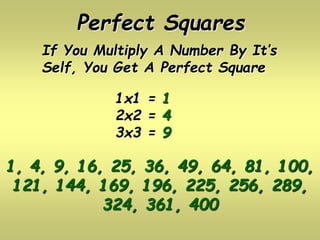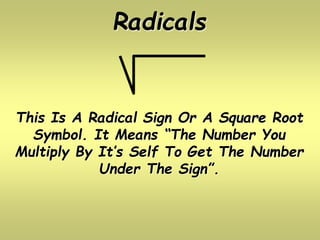Radicals.ppt
- 2. Perfect Squares If You Multiply A Number By ItŌĆÖs Self, You Get A Perfect Square 1x1 = 1 2x2 = 4 3x3 = 9 1, 4, 9, 16, 25, 36, 49, 64, 81, 100, 121, 144, 169, 196, 225, 256, 289, 324, 361, 400
- 3. Radicals This Is A Radical Sign Or A Square Root Symbol. It Means ŌĆ£The Number You Multiply By ItŌĆÖs Self To Get The Number Under The SignŌĆØ.
- 4. 25 = Radical 25, The Square Root Of 25, Or The Number You Multiply By ItŌĆÖs Self To Get 25 5 + -
- 5. 25 Positive root = 5 - 25 Negative root = -5 25 Both = -5, 5 + - Which Sign To Use ??
- 6. 36 81 144 9 = 6 = 9 = 12 = 3 Never Leave A Perfect Square Under A Radical Sign
- 7. 3 x 2 x 5 x 7 = When Multiplying Or Dividing Remember: Whole Numbers ( Rational Numbers ) With Whole Numbers And Radicals With Radicals. 3 5 x 2 7 = 6 35
- 8. 5 5 10 15 Whole Numbers ( Rational Numbers ) With Whole Numbers And Radicals With Radicals. 2 3 5 1 5 1 5 5 1 =
- 9. = 2 10 Never Leave A Number Under A Radical Sign That Has A Perfect Square As A Factor. ab = a x b = 5 2 40 = 4 10 x 50 25 2 = x
- 10. Divide Your Number By 2 And Check The Perfect Squares From That Point Down To 4. 240 240 / 2 = 120, So Check 240 / 100, 240 / 81 Etc. Until You Get A Whole Number As An Answer. 240 / 16 = 15 SoŌĆ”. = 16 x 15 = 4 15
- 11. Never Leave A Fraction Under A Radical Sign 3 4 = = = = 3 4 3 2
- 12. Never Leave A Radical In The Denominator Of A Fraction To Simplify This Expression We Rationalize The Denominator. Multiply The Denominator By Something That Gives Us A Rational Answer. We Can Usually Multiply It By ItŌĆÖs Self. Multiply The Top By The Same Thing. 3 5 = 3 5 5 5 5 x x
- 13. 2 5 3 x x 3 3 = = 2 15 3 = = 5 6 2 7 x x 7 7 5 42 2x7 = = 5 42 14












